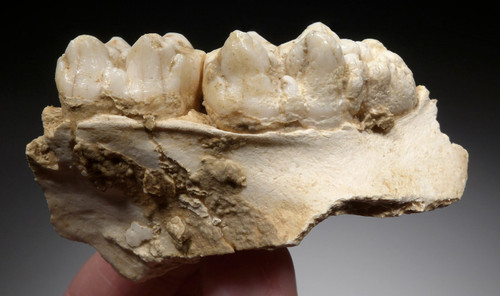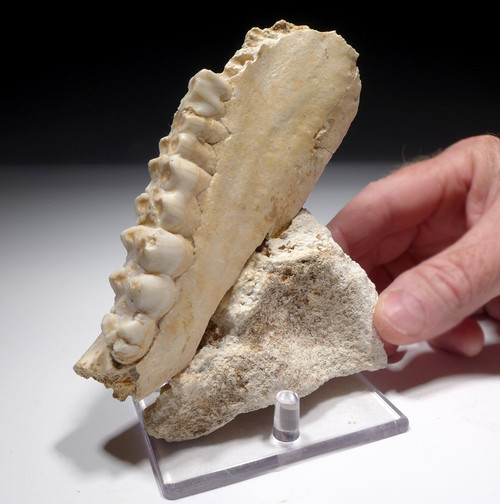Product Description
This SUPER RARE fossil wild boar primary stabbing tusk fossil is complete with full root base. It dates to Europe's final Ice Age and was collected from a cave in the Ardennes Forest of Belgium. The lower primary stabbing tusk is the main weapon of the wild boar and it is these tusks that make wild boars so incredibly dangerous! The long lower tusks are kept continuously sharp as they rub against the upper tusk. The specimen was found with a fracture near the tip hence the single repair. It was one of only FOUR complete fossil wild boar tusks of the entire collection! As explained further below, this was part of an Ice Age deposit of wild boar fossils that were left by Cave Hyenas once hunting the boars and bringing their carcasses back to their cave den to feed on them. We have a very limited number of these fossils from a single private collection - the only private collection of Ardennes Forest cave fossils from Belgium we have ever known of, or will ever have since fossil collecting in this area is forbidden and has been for a number of years.
Many years ago, we acquired a collection of cave fossils found in the Ardennes Forest of Belgium. The collection was formed in the 1960's and comprised fossils of predators such as Cave Bear and Cave Hyena, but also fossils of their prey such as Wild Boar. Despite a large part of our business and years of experience being based in Europe, this collection was the single instance ever, we have encountered cave fossils from Belgium! The cave deposit was wet, making the fossil preservation more fragile than usual, requiring the original collector to apply consolidant glue to the fossils in the field, sometimes in a crude manner. The fossils are much whiter in color than those found in the Carpathian Mountains of Romania, adding to their uniqueness. An interesting observation of the fossil layers indicates the boar were killed mostly by the Cave Hyenas and their carcasses brought back to the hyena den in the cave. According to the collector who originally dug the fossils, the layer of boar fossils were BELOW the layer of the hyena fossils, confirming this predator-prey relationship. For advanced Ice Age collectors, these fossils are a once-in-a-lifetime opportunity.
HISTORY
The wild boar, Sus scrofa, belongs to the Suidae family and are artiodactyls or 'even-toed' ungulates. These mammals usually have either two or four weight-bearing toes with hooves. The "cloven hoof" appearance is characteristic of pigs, deer and cattle. Wild boars probably originated in Southeast Asia during the Early Pleistocene, when the oldest known fossils date to, and out-competed other suid species as they spread throughout the Old World. The species is now one of the widest-ranging mammals in the world, as well as the most widespread suiform.
The wild boar is a large and extremely ferocious beast that still survives today. They have a saying in the Balkans that "you take a hunter with you when you want to kill a deer, but you take a priest with you when you want to kill a boar". Wild boars are fearless creatures that have been known to attack and many times, kill humans. The most impressive and dangerous weapon of the wild boar is its dagger-sharp lower tusks. Only male boars develop long canines in their lower jaws. The dramatic, curved tusks as well as the robust upper canines are continually growing and rubbing against each other thereby keeping the ends sharp at all times. Often, a boar will attack any animal in its way, swinging its massive head against the body of its unfortunate victim, repeatedly puncturing its enemy's body with swift stabs from its sharp tusks.
 US DOLLAR
US DOLLAR
 EURO
EURO
 AUSTRALIAN DOLLAR
AUSTRALIAN DOLLAR
 CANADIAN DOLLAR
CANADIAN DOLLAR
 POUND STERLING
POUND STERLING
















